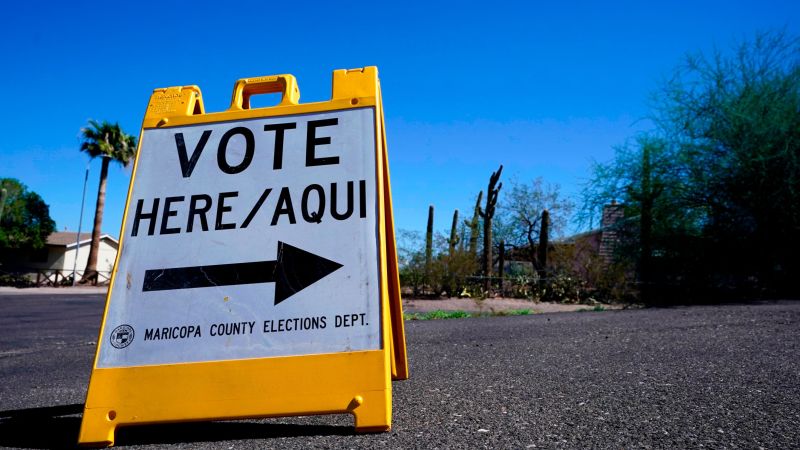Why Hispanic voters will have more power this year than ever before Analysis by Harry Enten Elections are, at the simplest level, won by putting together a coalition bigger than any other party. But the coalitions in America are changing with the times. Some of those changes are by choice, but other changes are driven by demographic changes.


CNN
—
Elections are, at the simplest level, won by putting together a coalition bigger than any other party. But the coalitions in America are changing with the times. Some of those changes are by choice, but other changes are driven by demographic changes.
One of those changes is the rising tide of Hispanic voters. They will likely play a more important role than ever before in determining whether the Democratic Party’s or the Republican Party’s coalition is bigger this year.
While we don’t know what the exact size Hispanic voters will make of the electorate, we do know that Hispanic voters (at 11%) made up more voters in 2020 than any prior national election, according to the US Census Bureau.
We also know that Hispanic voters were a larger share of the 2018 midterm electorate (at 9%) than any previous midterm. The 2018 midterm was additionally notable because Hispanics made up the same percent of voters as in the previous presidential election. If that is the case this year, then the Hispanic share of the electorate in 2022 will be the highest for a midterm election.
For a historical comparison, Hispanics made up only 5% of the electorate in the 2002 midterm (or about half the percentage they were in 2018).
The high percentage Hispanics made up of voters last midterm was boosted not just by the fact that Hispanics are making up a larger share of American adults but by the fact that a larger share of them turned out to vote.
A record high 40% of the Hispanic voting age eligible population turned out in 2018. That was about a 50% rise from 2014, which was about double the rise seen among non-Hispanic White Americans.
With other data indicating that we’ll be seeing high turnout nationally in 2022, it follows that we should see another year of high Hispanic turnout.
Of course, we don’t really hold national elections in the United States. The elections are held state-by-state and district-by-district.
It’s on the state level where the power of the Hispanic vote this year can really be seen. Control of the US Senate, at this point, seems like it will come down to four key races: Arizona, Georgia, Nevada and Pennsylvania. Democrats likely must win three of these states to retain control of the Senate.
The Hispanic share of the citizen voting age population of Georgia and Pennsylvania is lower than it is nationally. This shouldn’t be too surprising because a disproportionate share of Hispanics live in heavily populated states (e.g. California and Texas), which means Hispanics make up a below average share of the population in most states.
In Arizona and Nevada, it is a totally different ballgame. Hispanics made up 22% of voters in Arizona and 18% of voters in Nevada in 2022.
This means that Hispanic voters will probably have an outsized voice in which party wins the Senate this election. This is, in some ways, a statistical anomaly. There are only nine states where the Hispanic share of the citizen voting age population is bigger than it is nationally. It just so happens that two of those states are big battlegrounds this fall.
Hispanic voting power in the race for US House control is diluted, however.
I took a look at the 50 of the closest House races (as measured by FiveThirtyEight) and examined the share Hispanics make up of the voting age population. Just 12 of the 50 districts have a significantly larger share of Hispanics than the nation as a whole. The clear majority (64%) have a lower share of Hispanics than the national average.
The close House races where Hispanics will make up a significantly larger share than the nation as a whole will not come as much of a surprise to those who follow politics. They’re in California (9th, 13th, 22nd, 27th and 45th), Colorado (8th), New Mexico (2nd), Nevada (1st and 4th) and Texas (15th, 28th and 34th). In other words, they’re mostly in the southwest, just like the states with large Hispanic populations that will have an outsized voice in the race for the Senate.
A big question is whether either party will benefit greatly from high Hispanic turnout. Democrats will likely be helped given that polling shows Hispanics favor Democrats in the race for Congress. That same polling shows, though, that the margin Democrats are pulling among Hispanics isn’t anywhere as high as it was four years ago.
If that holds in the actual results, and given the Republican Party’s advantage among White voters, it may allow the GOP’s overall coalition to be greater in number than the Democratic Party’s.
Of course, we won’t know that until all the votes are cast and counted.






